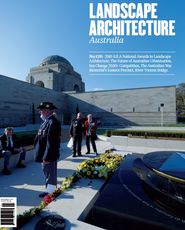Although August was a time of political uncertainty, at least the announcement of the 2010 AILA National Awards afforded us some professional clarity. The importance of the AILA National Awards goes beyond just acknowledging exemplary work. They provide a window into where the profession is going in terms of development trends and new innovations, as well as setting the benchmark of how we are currently defining good design in Australia.
This year, the jury had a formidable task of assessing sixty-six entries from across the country: New South Wales (eighteen), Victoria (eighteen), Queensland (eleven), Western Australia (eleven), South Australia (five), the Australian Capital Territory (two) and the Northern Territory (one).
From these, twenty were selected for awards – exactly half of these went to practices in New South Wales (ten), with the remaining to Victoria (four), Queensland (three), and Western Australia, South Australia and the Northern Territory each earning one.
What is most striking about the 2010 submissions is their focus on sustainability issues. Part of this can be attributed to the new entry requirement of justifying projects against the AILA Landscape Principles. However, juror Jennie Curtis believed it reflected a paradigm shift in how designers are now approaching projects: “Aspects of environmentally sensitive design, which were seen as new and innovative just two or three years ago, have now become just a matter of course.” Influencing this shift are clients, who increasingly require practices to demonstrate sustainable design initiatives as part of the tendering process.
In a country known for its coastline, it’s not surprising that many of the award submissions focused on waterfront redevelopment. What’s encouraging is that we’re doing it well, with nine of the twenty winning entries proposing designs that engage with the water’s edge. It’s reaffirming to see that city governments and developers are recognizing the value of our waterfronts and increasingly involve landscape architects in their reclamation as important public spaces.
We’re also making headway in embracing Australian history. Although it’s a relatively young country, designers are finding ways of using our cultural heritage to underpin site design concepts. Many projects demonstrated an appreciation of previous uses and materials through design moves that accentuated site histories. Practices are also continuing to find ways of promoting social sustainability through creative engagement with communities, whether in designing spaces for specific groups or providing guidance in imagining town futures.
But the awards also reveal some glaring gaps. For instance, the 2010 awards were missing bread-and-butter projects such as small-scale residential, subdivision development and shopping centre retrofits. Urban Design winner Rouse Hill Town Centre demonstrates that the work is being done (and in this case, incredibly well). But where were all the other examples? Perhaps practices don’t think the work qualifies under the Landscape Principles. Or that they are not as “sexy” as bigger projects. But they are some of the most common, which makes them just as important. Does their absence signal apathy in terms of their design? Or is it a limitation of the award criteria?
We’re beginning to take a greater interest in compiling data about the spaces we create – both scientific and social. We’re also starting to get better at standardizing and distributing this information. But based on the small number of projects that dribble in for the Research and Communication category, we can do better. On a day-to-day basis, practices are often exploring new materials, testing construction techniques, investigating methods of community engagement or assessing the latest representation technology. But rarely is this information compiled and circulated within the design community, let alone to the general public. If we are to advance as a profession – and within the design industry – we need to find ways of promoting the work that we do. Investing more time in research and its communication is one way of accomplishing this.
Of course, there is always the possibility that practices are choosing not to submit projects to the national awards. Out of approximately three hundred AILA-registered practices across the country, thirty-two participated in the national awards this year. That’s roughly 10 percent. In contrast, the 2008 AILA National Awards had ninety-six entries – that’s 30 percent more than this year. This raises many questions: are the awards capturing a fair representation of projects and firms? And if not, then why not? Was the introduction of the Landscape Principles into this year’s entry requirements too prescriptive for submissions? Or are the categories themselves off the mark? If the awards are trying to capture a bigger, more diverse applicant pool, should they be defined more by budget or project area, as done by some of our international counterparts?
Perhaps for an AILA-registered practice, entering one project into the national awards should be compulsory – like voting. Sure, it would require time, but it would provide some important professional introspection … and who knows, maybe even a prize.
Source

Archive
Published online: 14 Nov 2010
Words:
Gweneth Newman Leigh
Issue
Landscape Architecture Australia, November 2010














